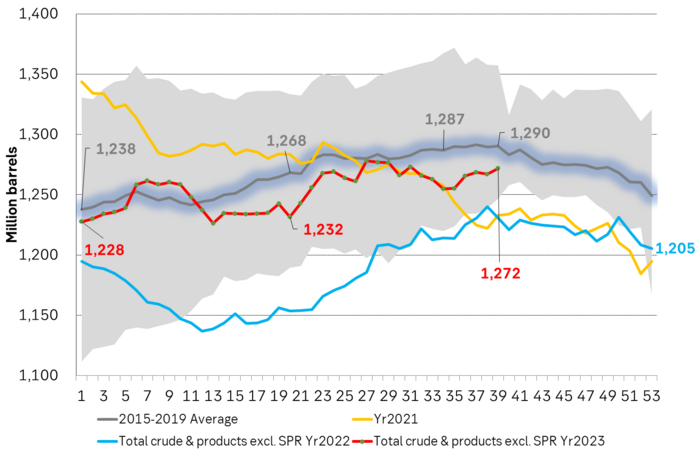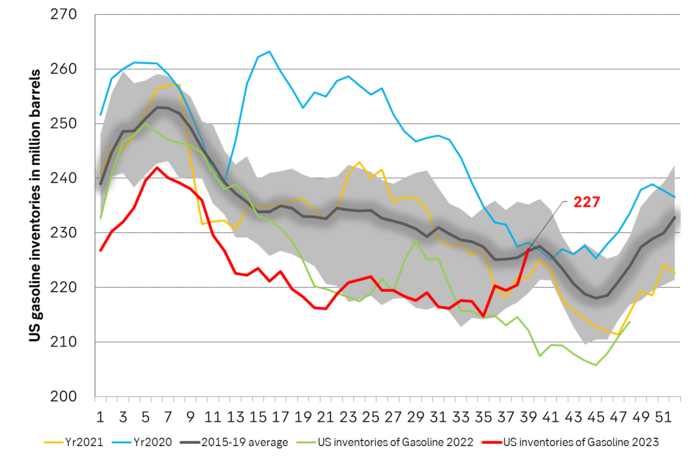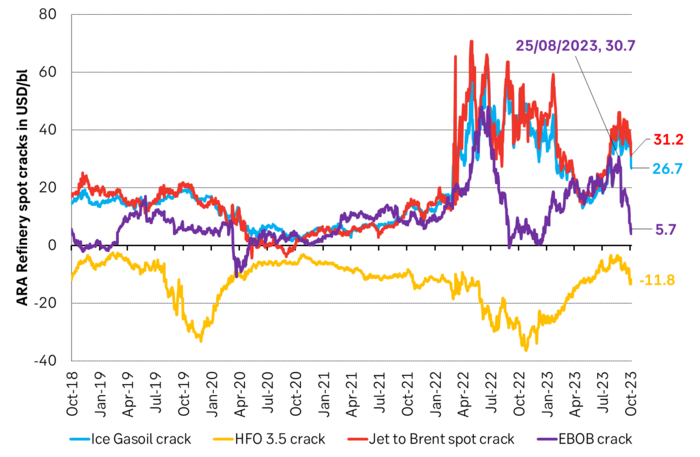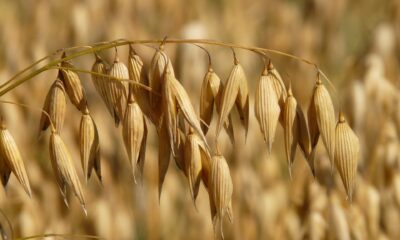Analys
Market doubting demand but Saudi/Russia are holding a steady course


Brent crude has sold off hard since 28 September. Fear for the health of the global economy and thus oil demand going forward is at the heart of the sell-off. Prior to that, a clarifying message from the Saudi Energy Minister, Prince Abdulaziz bin Salman, at a conference in Calgary on 18 September to a large degree also removed the USD 100/b plus scenario. Speculators had also accumulated significant long positions in oil since a low point in late June. And the last in have probably been hurt in the sell-off and tried to get out. Lastly we have the US oil inventories published on Wednesday this week which were very bearish as they rose almost 5 m b vs an normal draw this time of year of around 2 m b. And specifically gasoline stocks which jumped 6.5 m b to above the 2015-19 level with gasoline refining margins crashing as a result. But amid all this we still have Saudi/Russia which are holding a steady course with cuts and export reductions to end of year with Saudi spicing this up with Official Selling Price of its Extra Light crude to Europe at USD 7.2/b (Premium to Dubai crude) for November which is the highest since 2002. So USD 100/b plus is not in the cards. But neither is USD 50-60-70/b as Saudi his holding a steady course. Our bet is Brent crude averaging USD 85/b in Q4-23 in a balance between what Saudi Arabia wants and needs versus what is a sensible and acceptable level for the global economy.
The December Brent crude oil contract has fallen from an intraday high of USD 95.35/b on 28 September to now USD 83.9/b, a loss of USD 11.4/b. At heart of this decline is concerns for the outlook for the global economy and thus oil demand.
The clear and almost unanimous message from central banks across the board towards the end of September was ”interest rates higher for longer”. Add in flows for US government bonds where China and Japan no longer are big buyers (if at all), the US Fed is a net seller of bonds (QT) rather than a buyer (QE) while the US government is selling more and more bonds. This has driven the US 10yr government bond yield higher and higher to a recent peak of 4.8% which is the highest since 2007. With no relief in sight, this ”interest rate pain” is going to hurt the global economy and thus oil demand. This is probably one key reason/trigger for why oil has sold down so hard recently.
An other reason is probably the message to the market which Saudi Arabia’s energy minister, Prince Abdulaziz bin Salman, delivered to the market at a conference in Calgary on 18 September. He made it very clear that the current cuts were not about driving the oil price to the sky, but rather that it was precautionary versus uncertain demand. Further that if demand indeed turned out to be strong then hallelujah, they would produce more. The oil market has probably been a bit confused on this point with some saying that the aim of Saudi cuts was to drive crude oil above USD 100/b. Such kind of views was pushed aside by the Saudi minister. A sustained move above USD 100/b was very unlikely after the minister’s statements.
Speculators added more than 300 million barrels of net long positions late June. These have probably taken money off the table in the recent sell-off and thus contributed to the sharpness in the sell-off.
Then we have the US oil inventory data this Wednesday which gave a very bearish message to the market. Rather than a seasonal draw of around 2 m b the total US commercial crude and product stocks rose 4.6 m b. With this the US commercial oil stocks are only about 15 m b below the smoothed 2015-19 seasonal average. Gasoline stocks roes 6.5 m b to a level slightly above the 2015-19 average with implied US gasoline demand falling to the lowest level since 2008. The gasoline refining margin, the crack, has now collapsed to less than USD 6/b while it was more than USD 30/b in late August. US inventories of crude and middle distillates are still significantly below normal. In total almost 50 m b below the 2015-19 level. This is an uncomfortable situation ahead of the winter which keeps the market in a partial bullish grip.
A key bullish driver for crude oil has been the stellar overall refining margins. This has give refineries incentive to buy as much crude as they could and convert it to oil products which consumers could consume. Bullish for crude oil demand. A part of this bullishness has dissipated with the collapse of the gasoline crack. The diesel and jet fuel cracks are however still unusually strong at USD 26/b and USD 31/b vs. seasonal norms of around USD 16/b. Strong mid-dist cracks and still low inventories of middle distillates ahead of the winter will induce refineries to keep processing crude and churn out oil products. As such we should expect US gasoline stocks to continue higher. Gasoline cracks could thus drop yet lower from an already very low level.
But amid all this bearishness we still have OPEC+. We still have Saudi/Russia. And they are holding a strong and steady course. They are extending existing cuts and export reductions to the end of the year. They haven’t wavered for a second. Backing up this picture of steadfastness is the fact that Saudi Arabia has lifted its Official Selling Prices (OSPs) for November. By USD 0.5/b to USD 3.4/b for its Extra Light grade to Asia vs. a 10yr average of USD 2.3/b. And to Europe it has lifted it to USD 7.2/b which is the highest since 2002. These are reference prices vs. the Dubai marker. With this Saudi Arabia is saying to the market: ”You are free to buy our crude, but it will cost you”. It is a way of making its supply less available to the market. Making it more expensive.
Yes, Brent crude can of course sell off further and test the USD 80/b line for a little while. But Saudi/Russia are holding a steady course and USD 85/b is a great price. It should be acceptable for a shaky global economy as well as for Saudi/Russia for the time being.
The December Brent crude oil contract has fallen like a rock since its intraday high of USD 95.35/b on 28 Sep. Interest rates ”high for longer” has created deep concerns for oil demand going forward.

US commercial crude and product stocks are converging to the 2015-19 average and thus easing the bullishness in the market.

US gasoline stocks were up 6.5 m b last week and are now above the 2015-19 average. They could rise yet higher as implied demand is very weak and refineries keeps producing more gasoline because they are trying to satisfy the market’s craving for middle distillates where stocks are still low.

As a result the ARA gasoline crack has crashed to less than USD 6/b and could fall further.

But Saudi Arabia is holding a strong and steady course. It keeps its production at 9 m b/d vs. a normal of 10 m b/d to the end of the year. And to back it up it has lifted its official selling prices further to Asia and to the highest since 2002 to Europe (Extra Light).

Analys
Brent crude ticks higher on tension, but market structure stays soft

Brent crude has climbed roughly USD 1.5-2 per barrel since Friday, yet falling USD 0.3 per barrel this mornig and currently trading near USD 67.25/bbl after yesterday’s climb. While the rally reflects short-term geopolitical tension, price action has been choppy, and crude remains locked in a broader range – caught between supply-side pressure and spot resilience.

Prices have been supported by renewed Ukrainian drone strikes targeting Russian infrastructure. Over the weekend, falling debris triggered a fire at the 20mtpa Kirishi refinery, following last week’s attack on the key Primorsk terminal.
Argus estimates that these attacks have halted ish 300 kbl/d of Russian refining capacity in August and September. While the market impact is limited for now, the action signals Kyiv’s growing willingness to disrupt oil flows – supporting a soft geopolitical floor under prices.
The political environment is shifting: the EU is reportedly considering sanctions on Indian and Chinese firms facilitating Russian crude flows, while the U.S. has so far held back – despite Bessent warning that any action from Washington depends on broader European participation. Senator Graham has also publicly criticized NATO members like Slovakia and Hungary for continuing Russian oil imports.
It’s worth noting that China and India remain the two largest buyers of Russian barrels since the invasion of Ukraine. While New Delhi has been hit with 50% secondary tariffs, Beijing has been spared so far.
Still, the broader supply/demand balance leans bearish. Futures markets reflect this: Brent’s prompt spread (gauge of near-term tightness) has narrowed to the current USD 0.42/bl, down from USD 0.96/bl two months ago, pointing to weakening backwardation.
This aligns with expectations for a record surplus in 2026, largely driven by the faster-than-anticipated return of OPEC+ barrels to market. OPEC+ is gathering in Vienna this week to begin revising member production capacity estimates – setting the stage for new output baselines from 2027. The group aims to agree on how to define “maximum sustainable capacity,” with a proposal expected by year-end.
While the IEA pegs OPEC+ capacity at 47.9 million barrels per day, actual output in August was only 42.4 million barrels per day. Disagreements over data and quota fairness (especially from Iraq and Nigeria) have already delayed this process. Angola even quit the group last year after being assigned a lower target than expected. It also remains unclear whether Russia and Iraq can regain earlier output levels due to infrastructure constraints.
Also, macro remains another key driver this week. A 25bp Fed rate cut is widely expected tomorrow (Wednesday), and commodities in general could benefit a potential cut.
Summing up: Brent crude continues to drift sideways, finding near-term support from geopolitics and refining strength. But with surplus building and market structure softening, the upside may remain capped.
Analys
Volatile but going nowhere. Brent crude circles USD 66 as market weighs surplus vs risk

Brent crude is essentially flat on the week, but after a volatile ride. Prices started Monday near USD 65.5/bl, climbed steadily to a mid-week high of USD 67.8/bl on Wednesday evening, before falling sharply – losing about USD 2/bl during Thursday’s session.

Brent is currently trading around USD 65.8/bl, right back where it began. The volatility reflects the market’s ongoing struggle to balance growing surplus risks against persistent geopolitical uncertainty and resilient refined product margins. Thursday’s slide snapped a three-day rally and came largely in response to a string of bearish signals, most notably from the IEA’s updated short-term outlook.
The IEA now projects record global oversupply in 2026, reinforcing concerns flagged earlier by the U.S. EIA, which already sees inventories building this quarter. The forecast comes just days after OPEC+ confirmed it will continue returning idle barrels to the market in October – albeit at a slower pace of +137,000 bl/d. While modest, the move underscores a steady push to reclaim market share and adds to supply-side pressure into year-end.
Thursday’s price drop also followed geopolitical incidences: Israeli airstrikes reportedly targeted Hamas leadership in Doha, while Russian drones crossed into Polish airspace – events that initially sent crude higher as traders covered short positions.
Yet, sentiment remains broadly cautious. Strong refining margins and low inventories at key pricing hubs like Europe continue to support the downside. Chinese stockpiling of discounted Russian barrels and tightness in refined product markets – especially diesel – are also lending support.
On the demand side, the IEA revised up its 2025 global demand growth forecast by 60,000 bl/d to 740,000 bl/d YoY, while leaving 2026 unchanged at 698,000 bl/d. Interestingly, the agency also signaled that its next long-term report could show global oil demand rising through 2050.
Meanwhile, OPEC offered a contrasting view in its latest Monthly Oil Market Report, maintaining expectations for a supply deficit both this year and next, even as its members raise output. The group kept its demand growth estimates for 2025 and 2026 unchanged at 1.29 million bl/d and 1.38 million bl/d, respectively.
We continue to watch whether the bearish supply outlook will outweigh geopolitical risk, and if Brent can continue to find support above USD 65/bl – a level increasingly seen as a soft floor for OPEC+ policy.
Analys
Waiting for the surplus while we worry about Israel and Qatar

Brent crude makes some gains as Israel’s attack on Hamas in Qatar rattles markets. Brent crude spiked to a high of USD 67.38/b yesterday as Israel made a strike on Hamas in Qatar. But it wasn’t able to hold on to that level and only closed up 0.6% in the end at USD 66.39/b. This morning it is starting on the up with a gain of 0.9% at USD 67/b. Still rattled by Israel’s attack on Hamas in Qatar yesterday. Brent is getting some help on the margin this morning with Asian equities higher and copper gaining half a percent. But the dark cloud of surplus ahead is nonetheless hanging over the market with Brent trading two dollar lower than last Tuesday.

Geopolitical risk premiums in oil rarely lasts long unless actual supply disruption kicks in. While Israel’s attack on Hamas in Qatar is shocking, the geopolitical risk lifting crude oil yesterday and this morning is unlikely to last very long as such geopolitical risk premiums usually do not last long unless real disruption kicks in.
US API data yesterday indicated a US crude and product stock build last week of 3.1 mb. The US API last evening released partial US oil inventory data indicating that US crude stocks rose 1.3 mb and middle distillates rose 1.5 mb while gasoline rose 0.3 mb. In total a bit more than 3 mb increase. US crude and product stocks usually rise around 1 mb per week this time of year. So US commercial crude and product stock rose 2 mb over the past week adjusted for the seasonal norm. Official and complete data are due today at 16:30.
A 2 mb/week seasonally adj. US stock build implies a 1 – 1.4 mb/d global surplus if it is persistent. Assume that if the global oil market is running a surplus then some 20% to 30% of that surplus ends up in US commercial inventories. A 2 mb seasonally adjusted inventory build equals 286 kb/d. Divide by 0.2 to 0.3 and we get an implied global surplus of 950 kb/d to 1430 kb/d. A 2 mb/week seasonally adjusted build in US oil inventories is close to noise unless it is a persistent pattern every week.
US IEA STEO oil report: Robust surplus ahead and Brent averaging USD 51/b in 2026. The US EIA yesterday released its monthly STEO oil report. It projected a large and persistent surplus ahead. It estimates a global surplus of 2.2 m/d from September to December this year. A 2.4 mb/d surplus in Q1-26 and an average surplus for 2026 of 1.6 mb/d resulting in an average Brent crude oil price of USD 51/b next year. And that includes an assumption where OPEC crude oil production only averages 27.8 mb/d in 2026 versus 27.0 mb/d in 2024 and 28.6 mb/d in August.
Brent will feel the bear-pressure once US/OECD stocks starts visible build. In the meanwhile the oil market sits waiting for this projected surplus to materialize in US and OECD inventories. Once they visibly starts to build on a consistent basis, then Brent crude will likely quickly lose altitude. And unless some unforeseen supply disruption kicks in, it is bound to happen.
US IEA STEO September report. In total not much different than it was in January

US IEA STEO September report. US crude oil production contracting in 2026, but NGLs still growing. Close to zero net liquids growth in total.

-

 Nyheter4 veckor sedan
Nyheter4 veckor sedanMeta bygger ett AI-datacenter på 5 GW och 2,25 GW gaskraftverk
-

 Nyheter4 veckor sedan
Nyheter4 veckor sedanAker BP gör ett av Norges största oljefynd på ett decennium, stärker resurserna i Yggdrasilområdet
-

 Nyheter4 veckor sedan
Nyheter4 veckor sedanEtt samtal om koppar, kaffe och spannmål
-

 Analys4 veckor sedan
Analys4 veckor sedanBrent sideways on sanctions and peace talks
-

 Nyheter4 veckor sedan
Nyheter4 veckor sedanSommarens torka kan ge högre elpriser i höst
-

 Analys4 veckor sedan
Analys4 veckor sedanBrent edges higher as India–Russia oil trade draws U.S. ire and Powell takes the stage at Jackson Hole
-

 Nyheter3 veckor sedan
Nyheter3 veckor sedanMahvie Minerals är verksamt i guldrikt område i Finland
-

 Analys3 veckor sedan
Analys3 veckor sedanIncreasing risk that OPEC+ will unwind the last 1.65 mb/d of cuts when they meet on 7 September









